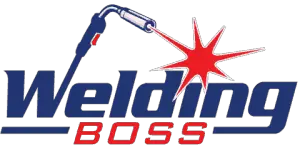This post contains affiliate links to products, services, or education. We may receive a commission for purchases made through links.
There are few things as frustrating as being in the middle of a welding project and running out of gas. If you’re thinking that it would be nice to know how long your gas will last or how to even know what size your gas cylinder is, stay tuned.
Common welding gas cylinder sizes. Since it is preferred for a better end-result, here are the most common Argon (AR) gas cylinder sizes for MIG (Metal Inert Gas) and TIG (Tungsten Inert Gas) welding:
| Tank Size (in Cubic Feet – commonly known as cf) | Tank Size Name | Tank Capacity | Tank Height in Inches | Tank Diameter in Inches | Approximate Tank Weight in Pounds |
| 20 | R | 21cf (Cubic Feet) | 17 | 5 | 17 |
| 40 | RR | 44cf | 24 | 7 | 25 |
| 60 | Q1 | 65cf | 21 | 7 | 29 |
| 80 | Q | 83cf | 32 | 7 | 47 |
| 125 or 150 | S* | 125cf or 155cf | 46 or 50 | 7.5 | 61 or 70 |
| 250 | K | 251cf | 51 | 8.5 | 133 |
| 330 | T | 335cf | 55 | 9.2 | 143 |
*Note: “S” tanks vary by supplier and geography. Ask your supplier which “S” tank size they have.
There are other types of gas cylinders and we will cover them in this article. You will also learn how to calculate how much welding you should be able to do with your particular gas cylinder.
How to Know What Kind of Gas is in the Cylinder
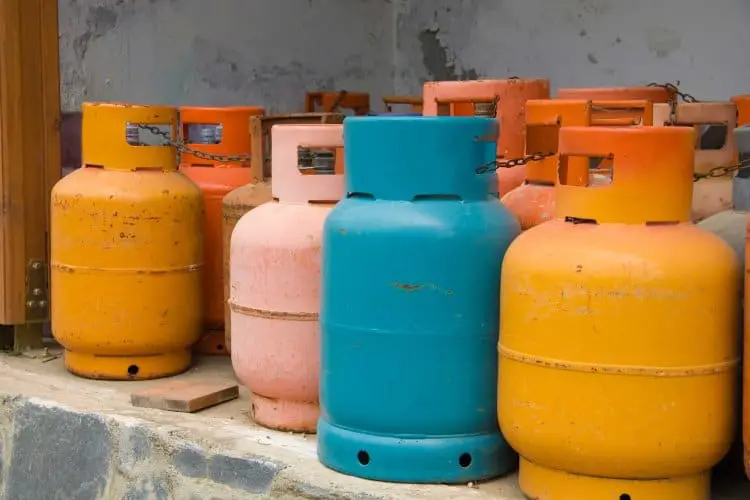
If someone has told you that you can tell what kind of gas is in a canister by the color of the canister, just smile and thank them and walk away. Fast!
Different manufacturers use different colors in the creation of their canisters, so they know that the tank is one of theirs.
The only way you can know with certainty what’s in that gas cylinder is to read the label. If you are considering buying a tank that doesn’t have a label, look for a different one instead. It isn’t worth the danger of buying a tank that has a different gas than what you’re expecting to use.
Various Types of Gas
Argon isn’t the only type of gas that is used for welding processes.
AR (Argon) AR/CO2 Mix and CO2 (Carbon Dioxide) Gas
Argon is the most common gas used in MIG or TIG welding because it provides cleaner results, but some use an Argon/CO2 mix or just CO2 instead.
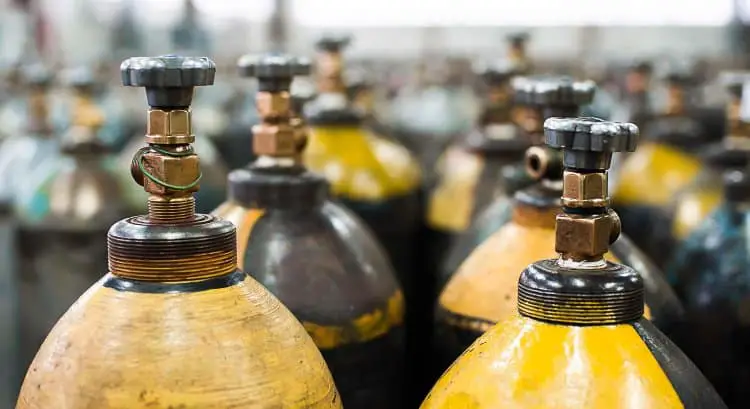
One word of caution… make sure you have sufficient ventilation available when working with these gasses as they can be lethal because they displace oxygen.
The Argon/CO2 mix doesn’t make as clean of a weld, and splatters more than pure argon, but it also costs less. The less argon, the more splatter you’re likely to experience. It can also be harder to find that “sweet spot” for good welds. Usually using a higher inductance setting works better for CO2 than what you would use for argon or a 75% AR/25% CO2 mix.
Because Carbon Dioxide is less expensive than Argon, some prefer to invert the mix so that it is a 75% CO2/25% AR or even 85% CO2/15% AR. It provides less splatter and a smoother bead than straight CO2, but still costs less than using a higher Argon mix.
CO2 or the AR/CO2 mix is typically used as a shielding gas when working with stainless steel and carbon. If your results don’t need to be pretty or clean, then this approach may work well for you.
Argon is also commonly mixed with:
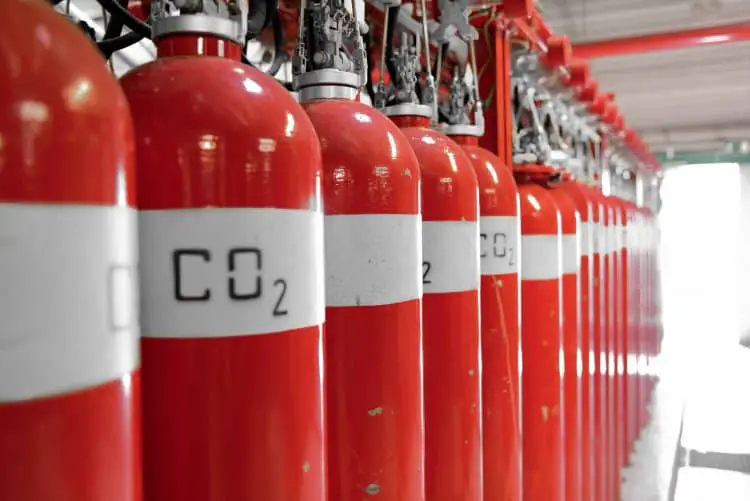
- Oxygen – Very little oxygen is typically mixed with Argon. The mix is used for light-gauge steel and material fusion. It creates the only flame hot enough to weld steel when it’s mixed with Acetylene.
- Helium – It’s not just for balloons anymore. Helium is generally used to provide a wide-shaped weld and to obtain a deep penetration.
- Hydrogen – This is used for accelerated TIG welding procedures.
Conveniently, Argon, Argon/CO2 mixes, and CO2 come in the same size containers. This proves the point that you need to read the labels on the canisters to make sure you are getting the correct gas-type.
Other Kinds of High-Pressure Cylinder Gasses
Additional types of gasses that come in the same sizes of cylinders are:
- Helium (He) – often used with aluminum, copper, and stainless steel (here is a helpful article on how to finish stainless steel after welding)
- Hydrogen (H2) – typically used as a shielding gas, and it is often combined with Argon to work on metals that require high temperatures, such as stainless steel. This is also the gas that is often used with the small torches associated with jewelry making. Hydrogen is the same gas that the sun uses to power itself – it’s naturally designed for intense heat.
- Nitrogen (N2) – Not used often, but when it is, it is usually combined with Argon to work on stainless steel. It can be used as a shielding gas for plasma cutting and laser welding. Nitrogen is not an appropriate gas to use when working with carbon steel.
How to Know What Size Cylinder I have
| Tank Size (in cf) | Tank Size Name | Tank Capacity | Estimated Amount of Use Time |
| 20 | R | 21cf (Cubic Feet) | 1-1.5 hours |
| 40 | RR | 44cf | 2-2.5 hours |
| 60 | Q1 | 65cf | 3-4 hours |
| 80 | Q | 83cf | 4-5 hours |
| 125 or 150 | S* | 125cf or 155cf | 6.5-10 hours (depending on size) |
| 250 | K | 251cf | 12.5-16.5 hours |
| 330 | T | 335cf | 16.5-22 hours |
Acetylene
This gas is highly flammable – which is good, since you need a flame to weld.
It is often mixed with oxygen and used for oxy-welding and oxy-fuel cutting.
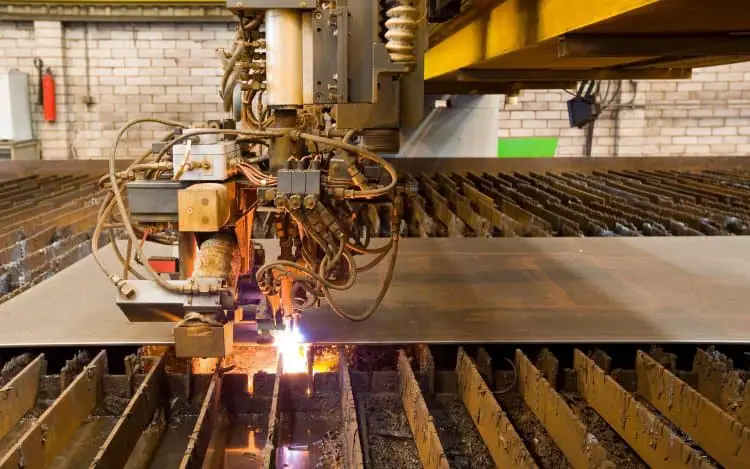
Although it is considered to be a low-pressure gas, it has a fairly high-pressure rating of 250 psi (pounds per square inch). Its volatile nature required special gas cylinders for storage. Common sizes are:
| Common Acetylene Cylinder Name | Common Acetylene Cylinder Capacity |
| MC | 10cf |
| B | 40cf |
| AX75 (Maybe WQ or A60) | 60-75cf |
| SM (Maybe WS) | 120-140cf |
| MED | 200-250cf |
| LG310 | 300-340cf |
| LG420 | 420cf |
*Note: Tanks over 125cf typically can only be leased from a vendor and not purchased outright.
Propane
Similar to Acetylene, Propane is also very combustible and flammable. Industry experts also call it LPG, or Liquid Petroleum Gas.
Interestingly, even though it’s so combustible, and will burn you if it comes into contact with your skin, it is mainly used after the welding process is finished for brazing.
Propylene
This flammable, colorless, liquified gas has a moderate BTU capacity when you compare it to Acetylene. It burns much hotter than Propane but has some of the benefits of Acetylene. It is also much safer than Acetylene and can be used at cold temperatures.
Propylene is an oxygen blend, so it isn’t considered to be a “pure” gas. It is effective when used for non-structural fusion welding, heating, and brazing.
How to Calculate How Long Your Gas Can Last
The general rule of thumb when calculating how long your gas will last is:
- Cylinder Volume in cf (cubic feet) / Regulator Flow Rate in cfh (cubic feet per hour) = Gas Welding Time (in hours)
- So… if you have a 60cf cylinder,
- Divided by a Regulated Flow of 20cfh,
- You can generally anticipate having about 3 hours of welding time.
One of the important things about this topic is that you first need to consider how much pre-flow and post-flow you will have during your process. If you are working on several small jobs and will have frequent starts and stops, you will be using more gas than if you are working on a larger project with long welds.
What are the Sizes of Welding Tanks?
As we mentioned earlier, these can vary slightly based on the manufacturer’s specifications. Even so, the typical dimensions for
High-Pressure Cylinders:
| Tank Size (in cf) | Tank Size Name | Tank Height in Inches | Tank Diameter in Inches | Approximate Tank Weight in Pounds |
| 20 | R | 17 | 5 | 17 |
| 40 | RR | 24 | 7 | 25 |
| 60 | Q1 | 21 | 7 | 29 |
| 80 | Q | 32 | 7 | 47 |
| 125 or 150 | S* | 46 or 50 | 7.5 | 61 or 70 |
| 250 | K | 51 | 8.5 | 133 |
| 330 | T | 55 | 9.2 | 143 |
Pro Tip: Generally, a 125cf Cylinder will last about the same amount of time as an 11-pound or 8-inch spool.
Acetylene Cylinders:
| Tank Size (in cf) | Tank Size Name | Tank Height in Inches | Tank Diameter in Inches | Approximate Tank Weight in Pounds |
| 10 | MC | 13 | 4 | 7 |
| 40 | B | 19.5 | 6 | 22 |
| 60-75 | AX75 (WQ) | 22.5 | 7 | 34 |
| 120-140 | SM (WS) | 35.5 | 85 | 87 |
| 200-250 | MED | 38 | 10 | 120 |
| 300-340 | LG310 | 41 | 12 | 168 |
| 420 | LG420 | 49 | 12 | 178 |
Propylene Cylinders:
| Tank Size (in cf) | Tank Height in Inches | Tank Diameter in Inches | Approximate Tank Weight in Pounds |
| 6 | 22 | 6 | 8 |
| 25.5 | 33 | 9 | 25.9 |
| 60 | 44 | 12 | 48 |
| 100 | 48 | 15 | 75 |
Propane Cylinders:
| Tank Size (in cf) | Tank Height in Inches | Tank Diameter in Inches | Approximate Tank Weight in Pounds |
| 20 | 14 | 5 | 11 |
| 40 | 17 | 7 | 24 |
| 60 | 23 | 7 | 29 |
| 80 | 32 | 7 | 47 |
| 125 | 43 | 7 | 58 |
| 150 | 47 | 7 | 61 |
| 200 | 51 | 9 | 117 |
When you consider the dimensions and weights of the various cylinders, it becomes a little more obvious which are intended to be portable and which would be stationary.
Finding the Right Size Cylinder
Knowing that you can typically purchase:
- Up-to a 125cf cylinder,
- That they weigh somewhere between 60ish to 80ish pounds, and
- That they’re usually somewhere between three and four feet tall,
Deciding which cylinder size is best for you becomes a decision as to how and where you’re going to use it.
One forum discussion suggested that you should “get the biggest one that fits your needs.”
That’s fine and dandy, but it really comes down to how you’re going to define your needs. Here are a few things to consider when making your decision:
- Refill frequency- Whether you need to go to a dealer to have your cylinders refilled or you have to schedule service, you will need to think about how often you want to fit that into your calendar.
- Portability-If you are going to be traveling to worksites, you will want something that is more portable and won’t cause an on-the-job injury from transporting it.
- Ventilation-In addition to having good ventilation while you’re working with the gasses, transporting gas also requires appropriate ventilation. Many of these gasses will eat up the oxygen you are breathing in your vehicle. Your ability to transport them safely also needs to be considered.
- Frequency of use-If you’re a hobbyist who will be working with your welding tools on an occasional basis, you might need a different sized cylinder than someone who is running a welding business.
- Exchangeability-When you’re working with your local welding gas dealer, make sure they will refill your existing tank or will exchange an empty for a full. Not all dealers work the same way.
Pro Tip: If you are moving to a different location/city/state, return your gas cylinders where you have them. Many dealers will not refill cylinders that did not come from their preferred manufacturer.
Gas Cylinder Safety
Here is a video on the basics (because I know you prefer videos like me 🙂
It may seem obvious, but there are a few things that are important to consider when working with your welding gasses.
- Ensure that your cylinder is in good working order.
Ok. That may seem obvious, but it’s usually the obvious steps that are overlooked because they seem so basic.
Check that the lines, manifolds, piping, and valves are secure and are without defect.
- Wear appropriate protective gear:
- Gloves
- Safety Glasses
- Safety Shoes (Steel-toed boots)
Check out our preferred welding gear here.
- Store cylinders at least 20-feet away from anything combustible like:
- Open flames
- Electricity
- Oil
- Grease
- Items that may contaminate them.
- Make sure valves are closed and the dust plug or pressure cap is secure when the cylinder is not in use.
Valves are a weak point on your cylinder. Use extra caution when transporting your cylinder, as well as when you are removing and replacing the pressure cap.
- Always move cylinders using a handcart designed for that purpose. This will prevent cylinders from being dropped or banged against one another.
Here are some examples of gas cylinder handcarts for transporting them from one location to another:
- Red Steel Welding Cart –This cart will hold two-9-inch diameter gas cylinders with a load of about 150-pounds plus it has a tool shelf that will hold an additional 35-pounds of equipment. Its oversized pneumatic tires will help give a smooth transition to the worksite regardless of how rough the terrain is.

- SAF-T-CART 920-6B – This cart is specifically designed for 80cf (75cf for acetylene) or smaller tanks. It has a chain to secure the tank while you move it from one location to another.

- Harper Trucks 142-86 Deluxe Welding Cylinder Hand Truck with 10-Inch Solid Rubber Wheels –This cart offers dual handlebars as well as handgrips. It has a holding chain and a hook for the hose. This cart also has welding rod holders. This has a 300-pound capacity and a one-year warranty.

- Never lift a gas cylinder by its valve cap. If the valve cap is not on tight, or has stripped threads, you might drop the cylinder and break or damage the valve. Now you’ve created your own personal explosive rocket that can seriously injure or kill anyone in its vicinity.
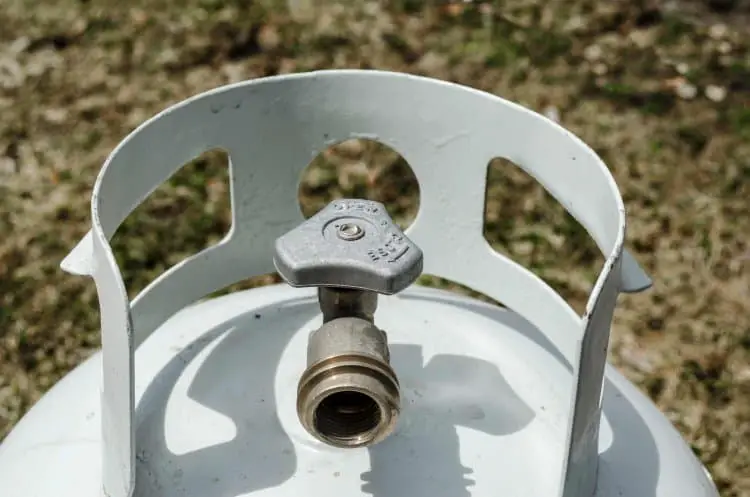
- Keep the gas cylinder and the valve clean.
- Store cylinders in an upright position on a level surface so they are not easily tipped over.
Here are a couple examples of possible storage options:
- Durham Steel/Iron Vertical Storage Cabinet EGCVC2-50 – 2-Cylinder Capacity –This locking cabinet has 14-gauge steel, expanded metal sides, and a durable safety yellow powder coat finish.
- Storage Cabinet Single Door Vertical, 9-Cylinder Capacity –This cage can be locked. It is made of 14-gauge steel for strength and has an acid resistant safety yellow powder coat finish. Magnetic catches keep the door(s) safely shut. It also has a chain to hold the cylinders in place.
- Make sure stored cylinders are strapped or chained in place and that empty cylinders are stored in a separate location than full cylinders.
Getting Down to Business
When it comes down to it, only you can ultimately decide what size of tank will best suit your needs and process.
Keeping in mind the general formula discussed earlier in the article:
Cylinder Volume in cf (cubic feet) / Regulator Flow Rate in cfh (cubic feet per hour) = Gas Welding Time (in hours)
It also depends on how much stopping and starting you’ll do. With these in mind, you’ll be able to decide what size tank will work best for you.
Regardless of whether you’re:
- A full-time business welder,
- A weekend warrior welder
- An artist using the medium for creativity,
There’s a gas cylinder size out there that will do what you need. A 125cf will generally give you two-full days of focused welding.
